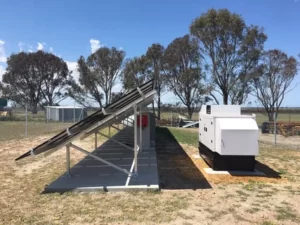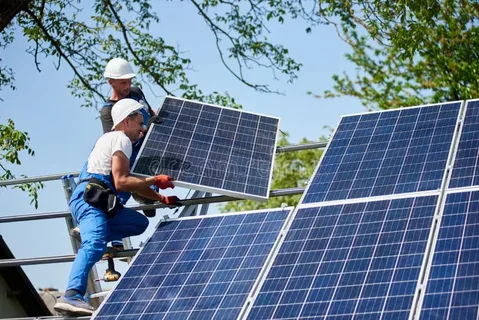Are you tired of constantly worrying about power outages or being tied down to the grid? Look no further than stand-alone power systems to give you the freedom and peace of mind you’ve been craving. These off-grid systems provide a reliable and sustainable source of energy that allows you to live unplugged while still being fully charged. With the advancements in technology, these systems have become more efficient and affordable, making them a viable option for both residential and commercial use. In this blog post, we’ll dive into the benefits and functionality of Stand Alone Power Systems, so you can see why they are quickly becoming the go-to choice for energy independence. Get ready to unplug and enjoy the endless possibilities with stand-alone power systems.
Why Stand-Alone Power Systems Are Becoming Essential?
As our world becomes more interconnected and reliant on technology, the electricity demand continues to rise. However, our traditional power grids are facing numerous challenges, including environmental concerns, aging infrastructure, and an increasing frequency of power outages. This is where stand-alone power systems come in.
Stand-alone power systems are becoming essential because they provide a reliable and sustainable solution to these challenges. By disconnecting from the grid and generating their own power, individuals and communities can ensure a constant and uninterrupted energy supply. This is especially important in remote areas or regions prone to power outages.
Moreover, stand-alone power systems offer a more sustainable energy alternative. They allow individuals to reduce their carbon footprint by relying on renewable energy sources, such as solar panels or wind turbines. By adopting these systems, we can reduce our reliance on fossil fuels and contribute to the fight against climate change.
Additionally, stand-alone power systems offer a level of energy independence and security. With their own power generation capabilities, individuals and communities are not at the mercy of the grid or external factors. They can maintain power even during blackouts or emergencies, ensuring the safety and well-being of themselves and their loved ones.
Understanding Stand-Alone Power Systems
In order to fully embrace the benefits of stand-alone power systems, it is important to have a clear understanding of how they work. Essentially, a stand-alone power system operates independently from the traditional power grid, generating its own electricity through renewable energy sources such as solar panels or wind turbines.
One key component of a stand-alone power system is the energy storage system, which allows for the storing of excess energy generated during periods of high production. This stored energy can then be used during times of low production or high demand, ensuring a consistent and reliable power supply.
Another important aspect to consider is the control system of a stand-alone power system, which manages the distribution and optimization of the generated electricity. This control system allows for efficient power management, ensuring that energy is directed where it is needed most.
In addition, stand-alone power systems often include backup generators or battery banks to provide an extra layer of security and reliability during periods of low renewable energy production or emergencies.
The Advantages of Adopting Stand-Alone Power Systems
Stand-alone power systems offer a myriad of advantages that make them an appealing option for individuals and communities looking to embrace a more sustainable and reliable energy solution.
One of the main advantages of adopting stand-alone power systems is the ability to reduce reliance on the traditional power grid. By generating their own electricity through renewable sources, such as solar panels or wind turbines, individuals can break free from the constraints and vulnerabilities of the grid. This means no more worrying about power outages or fluctuations in electricity supply. Stand-alone power systems provide a consistent and uninterrupted power source, ensuring that your life can remain fully charged, regardless of external factors.
Another key advantage is the potential cost savings. While the upfront costs of installing a stand-alone power system may be higher compared to staying connected to the grid, the long-term savings can be significant. With stand-alone power systems, you can greatly reduce or eliminate your monthly electricity bills, as you’ll be generating your own power for free from renewable sources. Over time, these savings can add up and provide a strong return on investment.
Stand-alone power systems also offer a greener and more environmentally friendly energy solution. By harnessing renewable energy, you can significantly reduce your carbon footprint and contribute to the fight against climate change. Traditional electricity generation often relies on fossil fuels, which release harmful greenhouse gases into the atmosphere. By embracing stand-alone power systems, you can make a positive impact on the environment and help create a more sustainable future.
 Maximizing the Potential of Stand-Alone Power Systems
Maximizing the Potential of Stand-Alone Power Systems
When it comes to stand-alone power systems, the potential for maximizing their benefits is immense. By taking advantage of these systems to their fullest extent, you can truly unplug from the grid and fully charge your life in a more sustainable and reliable way.
One way to maximize the potential of stand-alone power systems is to optimize your energy consumption. By being conscious of your energy usage and implementing energy-efficient practices, you can reduce the amount of power you need to generate. This can not only save you money in the long run but also extend the lifespan of your system.
Another way to maximize the potential of stand-alone power systems is to integrate them with other renewable energy technologies. For example, you can combine your solar panels with a wind turbine to ensure a more consistent and reliable power supply, even during periods of low sunlight.
Furthermore, staying informed about the latest advancements in stand-alone power systems can help you take advantage of new technologies and improvements. This can lead to increased efficiency, better performance, and ultimately, a more cost-effective and sustainable energy solution.
Factors to Consider Before Switching to Stand-Alone Power Systems
Before making the switch to stand-alone power systems, there are several important factors to consider. These considerations will help ensure that you make an informed decision and choose the right system for your needs.
First and foremost, you should assess your energy requirements. Take into account the appliances and devices you regularly use, as well as their energy consumption. This will help determine the size and capacity of the stand-alone power system you need.
Next, consider the location and surroundings of your property. Factors such as available sunlight for solar panels or wind conditions for turbines will affect the efficiency and effectiveness of your system. You should also assess the space available for installation and any potential obstructions that may impact the performance of your system.
Another important factor to consider is your budget. Stand-alone power systems can involve upfront costs for installation and equipment, so it’s important to set a budget and determine what you can afford. However, it’s also important to consider the long-term savings and return on investment that stand-alone power systems can offer.
Additionally, you should research and understand the maintenance requirements of the system you are considering. Regular maintenance and servicing may be necessary to ensure optimal performance and longevity.
Transitioning to Stand-Alone Power Systems: A Step-by-step Guide
Making the transition to stand-alone power systems may seem daunting at first, but with a step-by-step guide, the process becomes much easier. Here is a breakdown of the key steps to follow when transitioning to stand-alone power systems:
- Assess your energy needs: Start by evaluating your current energy consumption. Take note of the appliances and devices you regularly use and their energy requirements. This will help you determine the size and capacity of the stand-alone power system you need.
- Research renewable energy sources: Look into the different renewable energy sources available, such as solar panels and wind turbines. Consider the feasibility and suitability of each option based on your location and environmental conditions.
- Set a budget: Determine your budget for the transition. Consider the upfront costs of installation and equipment, as well as the long-term savings and return on investment that stand-alone power systems can provide.
- Consult with professionals: Seek advice from professionals and experts in stand-alone power systems. They can guide you through the process, provide recommendations, and answer any questions or concerns you may have.
- Choose a reputable supplier: Research and select a reliable supplier for your stand-alone power system. Ensure they have a good track record and offer quality products and services.
- Installation and setup: Once you have chosen a supplier, they will install and set up your stand-alone power system. Ensure that they provide thorough training on system operation and maintenance.
- Monitor and maintain: Regularly monitor and maintain your stand-alone power system to ensure optimal performance. This may include checking for any issues or inefficiencies, cleaning solar panels, and performing routine maintenance tasks.
Embracing Sustainability with Stand Alone Power Systems
Embracing sustainability is not just a buzzword; it’s a mindset and a lifestyle choice. With stand-alone power systems, you have the opportunity to truly embrace sustainability and make a positive impact on the environment. By generating your own electricity through renewable sources, such as solar panels or wind turbines, you are reducing your reliance on fossil fuels and reducing your carbon footprint.
Stand Alone Power Systems allow you to take control of your energy consumption and live a more sustainable life. You can monitor your energy usage and make adjustments to minimize waste and maximize efficiency. With a greater understanding of how your energy is generated and consumed, you can make informed choices to reduce your overall energy consumption and minimize your impact on the planet.
Furthermore, stand-alone power systems offer the opportunity to become more self-sufficient and resilient. You are no longer at the mercy of power outages or disruptions in the grid. With your own power generation capabilities, you can maintain a constant and reliable energy supply, even during emergencies or blackouts.
FAQs
1. How do stand-alone power systems work?
Stand-alone power systems operate independently from the traditional power grid, generating their own electricity through renewable energy sources like solar panels or wind turbines. They store excess energy for use during low-production or high-demand periods.
2. Can I completely disconnect from the grid with a stand-alone power system?
Yes, stand-alone power systems allow you to fully disconnect from the grid and rely solely on your own generated power. This offers greater independence and security during blackouts or emergencies.
3. Are stand alone power systems expensive?
While the upfront costs may be higher compared to staying connected to the grid, stand-alone power systems can provide significant long-term savings. You’ll reduce or eliminate monthly electricity bills and generate free power from renewable sources.
4. Do stand-alone power systems require a lot of maintenance?
Regular maintenance is necessary to ensure optimal performance of stand-alone power systems. This includes monitoring and servicing the system, cleaning solar panels, and checking for any issues or inefficiencies.
Conclusion
In a world that is becoming increasingly reliant on technology and facing numerous challenges with traditional power grids, stand-alone power systems offer a reliable and sustainable solution. These systems provide the freedom and peace of mind of living unplugged while still being fully charged. With advancements in technology, stand-alone power systems have become more efficient and affordable, making them a viable option for both residential and commercial use. By embracing stand-alone power systems, you can reduce your reliance on the grid, contribute to a greener future, and enjoy the benefits of energy independence. So why wait? Embrace the possibilities and make the switch to stand-alone power systems today.



